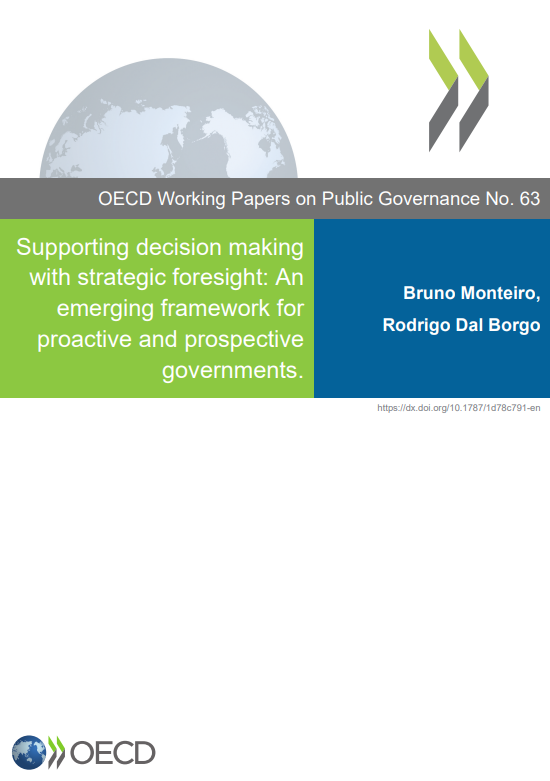Supporting decision making with strategic foresight: An emerging framework for proactive and prospective governments

Executive summary
This working paper discusses strategic foresight initiatives and methodologies that support decision making and process design. It highlights case studies, international benchmarks, and best practices as well as methodological recommendations and options to promote the adoption and use of strategic foresight in government. The paper is structured in four sections, each centred on a critical action to improve decision making through strategic foresight: (i) framing strategic foresight, (ii) building its fundamental components in governments, (iii) fine-tuning foresight interventions to specific contexts, and (iv) doing concrete activities to solve specific policy challenges. Given its exploratory nature, this working paper and its proposals must be seen as contributions to the ongoing debates about the use of strategic foresight for decision making in government. As such, rather than a definitive set of assertions, this working paper raises hypotheses to be tested, improved and, if need be, criticised.
To help governments become more proactive and prospective, strategic foresight needs to be framed through a systemic governance approach. Foresight analysis and insights of possible futures also need to be matched with concrete actions in the present. Bridging the strategic foresight impact gap – i.e. the distance separating foresight expertise and its actual implementation to target policy goals – involves mobilising and embedding strategic foresight into government functions and mechanisms. This working paper advocates for the use of systemic approaches to identify and access the elements that sustain the effective use of strategic foresight in government. At the practical level, the paper introduces prompt questions and tools for governments to use this systemic approach for purposeful interventions.
In order to build sustained and effective strategic foresight systems in governments, the Strategic Foresight Unit (SFU) of the OECD proposes a set of systemic elements, namely demand and mandate, capabilities and skills, institutional arrangements, embeddedness in policymaking, and feedback and learning loops. Sustained support and demand for strategic foresight, especially from high-level sponsors and “champions”, is needed to ensure its systematic application. Fostering the adoption of foresight requires a clear definition of mandates and the allocation of responsibilities to government organisations and actors. This working paper also highlights important capabilities and skills that need to be nurtured across the whole public sector, at the level of public sector organisations, and among individual public sector managers and staff. Using examples to illustrate the diversity of strategic foresight institutionalisation processes and formats, the paper highlights the relevance of institutional arrangements, such as a strong and direct connection with the policy arena, the creation of legislation and regulatory incentives, the support to specialised agencies benefiting from explicit (and transversal) mandates, and the professionalisation of practitioners and their careers and expertise. To best respond to the needs and expectations of its users, strategic foresight also needs to incorporate learning loops, which enable the constant improvement of its approaches. Regarding its embeddedness in policymaking, the paper highlights eight functions that foresight performs for decision makers:
- Strategic foresight can help decision makers’ self-reflection, enabling them to articulate unasked questions, debunk implicit biases and identify assumptions that sustain their daily routines.
- Foresight approaches provide useful insights for decision makers, creating high-quality, robust and reliable outputs to improve the impact of policymaking.
- Foresight practices, processes and products can steward the implementation of public policies, providing constant awareness about ongoing, unpredictable changes or long-term impacts of public policies.
- Strategic foresight helps to mobilise and mediate stakeholders’ participation and co-creation around the exploration and debate about plausible and desirable futures.
- Engagement with futures can nurture empathy among stakeholders, enabling the mutual understanding of diverse points of view about the future and contributing to the establishment of common ground.
- Strategic foresight offers decision makers scope to experiment, including stress-test options regarding the future and probes into potential future paths and outcomes based on present-day decisions.
- Decision makers can acquire or improve their skills, such as their ability to account for sustainability or their agility to cope with unexpected events.
- Through its incentives to adopt longer-term, forward-looking perspectives, strategic foresight can drive decision makers’ imagination to express and inspire possible futures and alternative narratives of uncertain and complex scenarios.
Foresight approaches work best when fine-tuned to their specific context of application. The acknowledgement of barriers as well as enablers is an important step in the design of adaptable, achievable, robust and context-adjusted strategic foresight processes and interventions. This working paper provides an extensive review of strategic foresight barriers and enablers identified in cases around the globe. The most apparent obstacles to strategic foresight adoption and use in government include short-termism and risk aversion, scarcity of specialised skills in public administration, or the existence of organisational and sectoral silos. The limited accessibility or lack of timeliness of strategic foresight products for decision makers and the underuse of evaluation instruments are also seen as hindrances. Among the enabling factors, this paper highlights the involvement and buy-in of policymakers, the credibility and reputation of strategic foresight units and practitioners, and their ability to grasp and participate in public debates. Sufficient resources, clear ownership and strong mandates for strategic foresight are necessary across institutional arrangements. High-quality expertise and pertinent skillsets, as well as pockets of talent or teams equipped to operate transversally in government, all support strategic foresight implementation. Providing policymakers with relevant, usable and accessible outputs is critical to embed strategic foresight in the policy cycle. Regular interaction with users to gather their feedback and impact assessment exercises are necessary for the continuous improvement of strategic foresight processes and practices. This working paper introduces a blueprint of critical factors for the acceptance and use of strategic foresight in government to help governments tailor strategic foresight interventions to their specificcontext.
The value of strategic foresight lies primarily in its application to decision making. Robust methodologies need to be applied through a structured process of concrete actions that ensures strategic foresight is fit-for-purpose and impactful. This working paper reviews distinct models that explore strategic foresight as an iterative and actionable approach articulated through a portfolio of methods and tools. It explores in detail the application of strategic foresight to selected priority topics: green and energy transition, and equity and social cohesion. For each of these topics, the working paper identifies and shares experiences and lessons from relevant use cases.
Finally, this working paper highlights five areas of opportunity for PlanAPP to explore in Portugal:
- Given its position in the Centre of Government, PlanAPP can promote the collaborative design of a transversal strategy for foresight in the Portuguese public administration with an associated roadmap for action, providing the direction and defining the resources required to generate stronger and effective capacities and initiatives.
- Develop a scan of the whole strategic foresight ecosystem in Portugal in order to map, in detail, its actors and their interconnections, as well as identify its specific barriers and enablers.
- Use its mission and mandate to promote concrete interventions that focus on specific projects, either domain-specific or challenge-based, applying strategic foresight approaches on the ground and oriented toward tangible outcomes.
- Upgrade ongoing initiatives to connect existing practitioners in the Government of Portugal. The creation of a foresight community of practice would increase interaction and collaboration across sectors and organisations.
- Promote exchanges with international partners, benefiting from contacts already established, to share lessons and build cross-border initiatives to match global challenges.
This working paper provides guidance for governments to further promote and disseminate strategic foresight for decision making. The paper reviews substantive knowledge and research about strategic foresight and gathers a series of international case study examples. It also offers methodological guidance and suggests actions for designing and updating strategies and interventions that integrate strategic foresight approaches. Through all these contributions, the paper sets an emerging framework for proactive and prospective governments.

Supporting decision making with strategic foresight: An emerging framework for proactive and prospective governments
Published: 11 September 2023
